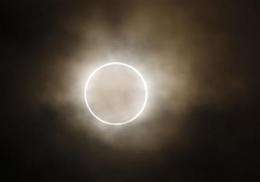Webcasts push solar eclipse to the masses

(AP) -- It was one of the best places in the western United States to watch the annular solar eclipse, and people drove for days just to get to this dusty stretch west of Albuquerque.
Did it matter?
Some say no. The game of chasing celestial spectacles like Sunday's eclipse has forever changed thanks to live webcasting by astronomy experts and social network sites that are being fueled by grainy smartphone photographs and video clips.
The National Park Service streamed the eclipse live on its website from Petroglyph National Monument. It marked a first for the agency.
Across town, the University of New Mexico was doing the same. In Japan, Panasonic went live from Mount Fuji.
UNM astronomy professor Richard Rand says this new way of experiencing eclipses and other celestial events can only add to their understanding and result in more interest in science.
©2012 The Associated Press. All rights reserved. This material may not be published, broadcast, rewritten or redistributed.



















